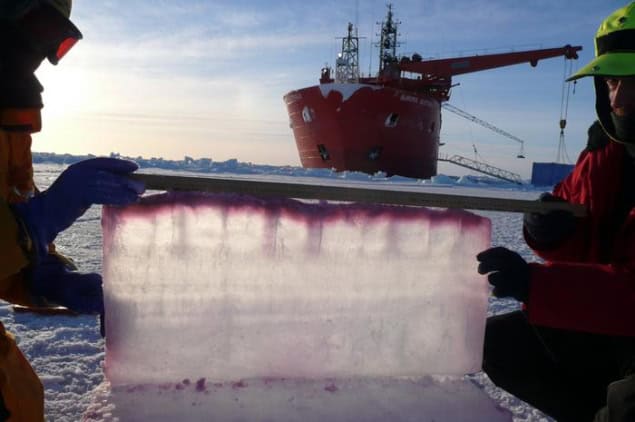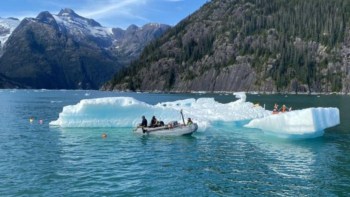
The thermal conductivity of sea ice can significantly increase when convective flow is present within the ice. This new result, from researchers at Macquarie University, Australia, and the University of Utah and Dartmouth College, both in the US, could allow for more accurate climate models – especially since current global models only account for temperature and salinity and not convective flow.
Around 15% of the ocean’s surface will be covered with sea ice at some time in a year. Sea ice is a thin layer that separates the atmosphere and the ocean and it is responsible for regulating heat exchange between the two in the polar regions of our planet. The thermal conductivity of sea ice is a key parameter in climate models. It has proved difficult to measure, however, because of its complex structure, made up of ice, air bubbles and brine inclusions, which form as the ice freezes from the surface of the ocean to deeper down. Indeed, sea ice can be thought of as being a porous composite material and is therefore very sensitive to changes in temperature and salinity.
The salty liquid within the brine inclusions is heavier than fresh ocean water. This results in convective flow within the ice, creating channels through which liquid can flow out, explains applied mathematician Noa Kraitzman at Macquarie, who led this new research effort. “Our new framework characterizes enhanced thermal transport in porous sea ice by combining advection-diffusion processes with homogenization theory, which simplifies complex physical properties into an effective bulk coefficient.”
Thermal conductivity of sea ice can increase by a factor of two to three
The new work builds on a 2001 study in which researchers observed an increase in thermal conductivity in sea ice at warmer temperatures. “In our calculations, we had to derive new bounds on the effective thermal conductivity, while also accounting for complex, two-dimensional convective fluid flow and developing a theoretical model that could be directly compared with experimental measurements in the field,” explains Kraitzman. “We employed Padé approximations to obtain the required bounds and parametrized the Péclet number specifically for sea ice, considering it as a saturated rock.”
Padé approximations are routinely used to approximate a function by a rational analysis of given order and the Péclet number is a dimensionless parameter defined as the ratio between the rate of advection to the rate of diffusion.

Arctic sea ice loss affects the jet stream
The results suggest that the effective thermal conductivity of sea ice can increase by a factor of two to three because of conductive flow, especially in the lower, warmer sections of the ice, where temperature and the ice’s permeability favour convection, Kraitzman tells Physics World. “This enhancement is mainly confined to the bottom 10 cm during the freezing season, when convective flows are present within the sea ice. Incorporating these bounds into global climate models could improve their ability to predict thermal transport through sea ice, resulting in more accurate predictions of sea ice melt rates.”
Looking forward, Kraitzman and colleagues say they now hope to acquire additional field measurements to refine and validate their model. They also want to extend their mathematical framework to include more general 3D flows and incorporate the complex fluid exchange processes that exist between ocean and sea ice. “By addressing these different areas, we aim to improve the accuracy and applicability of our model, particularly in ocean-sea ice interaction models, aiming for a better understanding of polar heat exchange processes and their global impacts,” says Kraitzman.
The present work is detailed in Proceedings of the Royal Society A.



